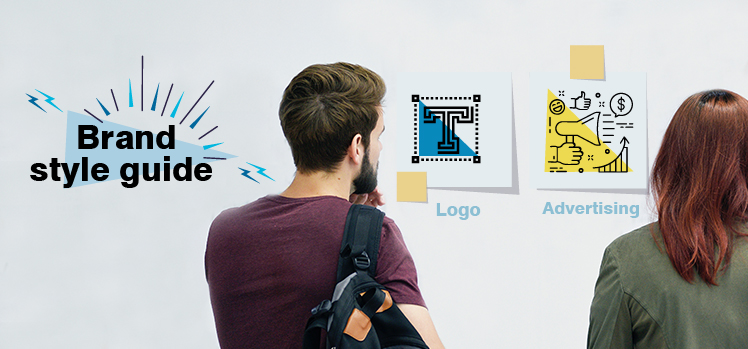How to create your company’s brand style guide
If you’re reading this blog, you have at least heard of a brand style guide. You probably also have questions about what exactly one is, why it’s essential to have one, and how to create one.
That’s why I’m here: to answer these questions and empower you to build a killer branding style guide that solidifies your brand’s image and personality.
What is a brand style guide?
A brand style guide defines your branding. It lays out how your brand is presented to and perceived by the market. It includes an array of specifications around your brand’s logo, color schemes, fonts, core messaging, and more. It provides continuity to the look and feel of your brand.
Why do you need brand continuity?

Branding continuity is important because it allows consumers to recognize your brand whenever they see it. It decreases confusion caused by the use of inconsistent logos, fonts, colors, etc.
Research reveals that consistent branding increases company revenue by 23%, which underscores the importance of having a brand style guide that is strictly enforced on all customer- and prospect- facing materials. That includes your website, emails, landing pages, social media sites, product collateral, etc.
Moreover, Circle Research reports that 77% of marketers say that branding is crucial to growing your business. Consistent branding differentiates ordinary companies from outstanding ones. But how do you build a brand style guide and what do you need to include? Below we’ll dig in.
What are the key pieces of a brand style guide?

Building a brand style guide is not rocket science. You can easily find a free brand style guide template online. But it’s important to understand the key components involved and how to create them.
Company logo
Your logo is the heart of your branding. It’s all over your marketing materials. First and foremost, it’s how consumers recognize and identify your brand. Think of McDonald’s and their iconic golden arches. Around the globe, when someone sees that big yellow “M” they immediately know that there is a McDonald’s nearby.
That is the kind of recognition that you want your logo to create. Of course, we’re not all going to be the next McDonald’s, but that is the type of brand awareness and recognition you are aiming for.
Your logo needs to be eye-catching and memorable, but that is a design issue. The important thing is that you define your logo and always use the same one so that when someone sees it, they know it’s you. A free logo maker can be a good way to explore ideas and see what the logo will look like on social media, billboards or storefront.
If you decide you don’t like it, you can change it later in a rebranding effort. Logos evolve over time; even McDonald’s has had various logos over the years. But don’t change too often or you’ll confuse the market.
Color scheme

Your logo will have colors unless it’s black and white. Even if your logo is black and white, you will almost certainly use colors for the text on your website, collateral, etc. It’s important that you define what those colors are and use them consistently.
You don’t want some web pages to have red headers and others to have green headers. Consistency is super important. Furthermore, you don’t want to have varying tones of red headers (or any other color for that matter) on different pages. You need to determine which colors make up your color scheme to a high degree of specificity. Take note of the Hex and GBR numbers of your colors and ensure the colors you include in your color scheme always use that exact tone.
For example, Agile CRM’s blue uses the following RGB code: 64, 156, 227. If even one of those numbers is changed by a few degrees, the tone will be different, and you’ll have inconsistent branding.
Naming convention for branding
What is your company’s name? Do you always refer to it the same way in written materials? You need to. The same goes for your products. Don’t call your company or product by a nickname. Again, consistency is key when you are struggling to come up with business name ideas.
For example, our company is called “Agile CRM.” We never refer to it just as “Agile” nor do we ever remove the space and call it “AgileCRM.”
The same goes for your products. For example, Nike sells a shoe called the “Air Jordan.” However, you will never see any official company materials that refer to it just as the “Jordan.” You get the point.
That kind of inconsistency will hurt your bottom line and confuse consumers. According to Lucid Press, the most negative impact of inconsistent branding is causing confusion in the market.
Font usage

Your materials should always use the same font or set of fonts. Select one font for headers, and perhaps another one for body text. Or, select one font and stick to just that one.
It’s also important to use the same font sizes for the various written components in your materials. Use one size for headers, another for subheaders, a third for body text, and so on. You should also apply these font rules to any call-to-action buttons you use.
Company persona
How do you want the public to view your company? If you sell toys, you probably want to come across as playful. If you sell financial services, you would want to come across as more serious. You should define this while you build your brand style guide, as it will dictate the tone and voice of the content you produce.
Mission and vision statements

Your mission and vision statements define what your ultimate goal is as a company. Your vision is where you want to be as a company, and your mission is how you plan to get there. This helps keep your whole company aligned around the same set of goals and values. Learn more about mission and vision statements.
Value proposition
What does your company offer to the consumer that differentiates it from the competition? Identify that, and that will be the basis for your value proposition (commonly referred to as a value prop).
Southwest Airlines offers us a good example. They do not charge you a fee to change your flight date and time, only the difference of the cost of the ticket (if there is one). Nearly all other airlines charge ludicrous change fees.
So, their value prop could be that they offer a superior customer experience by being empathetic to customers’ needs and not charging passengers to change a ticket. Think about what sets you apart. Then refer back to that in your content when speaking to customers or prospects, etc.
Conclusion
At this point, you hopefully realize that consistent branding is of the utmost importance. Inconsistent branding not only confuses people, stunts revenue growth, and negatively impacts your ability to expand, it also looks unprofessional and amateur.
If you don’t have a brand style guide, don’t worry; it’s fairly easy to pull one together. The most time-consuming part is defining the individual elements. Many new, small, and growing businesses don’t have one, so don’t feel bad if you’re just getting started. Now that you know what the essential components of a brand style guide are, you should be able to create one fairly easily.
Do you have any questions about consistent branding? Feel free to post them in the comments section below.

No Comments